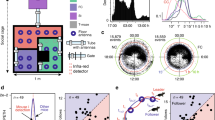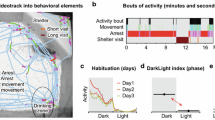Abstract
Indirect genetic effects (IGEs; the heritable influence of one organism on a conspecific) can affect the evolutionary dynamics of complex traits, including behavior. Voluntary wheel running is an important model system in quantitative genetic studies of behavior, but the possibility of IGEs on wheel running and its components (time spent running and average running speed) has not been examined. Here, we analyze a dataset from a replicated selection experiment on wheel running (11,420 control and 26,575 selected mice measured over 78 generations) in which the standard measurement protocol allowed for the possibility of IGEs occurring through odors because mice were provided with clean cages attached to a clean wheel or a wheel previously occupied by another mouse for 6 days. Overall, mice ran less on previously occupied wheels than on clean wheels, and they ran significantly less when following a male than a female. Significant interactions indicated that the reduction in running was more pronounced for females than males and for mice from selected lines than control mice. Pedigree-based “animal model” analyses revealed significant IGEs for running distance (the trait under selection), with effect sizes considerably higher for the initial/exploratory phase (i.e., first two of six test days). Our results demonstrate that IGEs can occur in mice interacting through scent only, possibly because they attempt to avoid conspecifics.



Similar content being viewed by others
References
Butler D, Cullis BR, Gilmour AR, Gogel DJ (2007) ASReml-R reference manual release 2.0. VSN International Ltd., Hemel Hempstead
Camerlink I, Ursinus WW, Bijma P, Kemp B, Bolhuis JE (2015) Indirect genetic effects for growth rate in domestic pigs alter aggressive and manipulative biting behaviour. Behav Genet 45(1):117–126
Careau V, Bininda-Emonds ORP, Ordonez G, Garland T Jr (2012) Are voluntary wheel running and open-field behavior correlated in mice? Different answers from comparative and artificial selection approaches. Behav Genet 42(5):830–844
Careau V, Wolak ME, Carter PA, Garland T Jr (2013) Limits to behavioral evolution: the quantitative genetics of a complex trait under directional selection. Evolution 67(11):3102–3119
Careau V, Wolak ME, Carter PA, Garland T Jr (2015) Evolution of the additive genetic variance–covariance matrix under continuous directional selection on a complex behavioural phenotype. Proc R Soc B 282(1819):20151119
Carter PA, Swallow JG, Davis SJ, Garland T Jr (2000) Nesting behavior of house mice (Mus domesticus) selected for increased wheel-running activity. Behav Genet 30(1):85–94
Dingemanse NJ, Araya-Ajoy YG (2015) Interacting personalities: Behavioural ecology meets quantitative genetics. Trends Ecol Evol 30(2):88–96
Drickamer LC, Evans TR (1996) Chemosignals and activity of wild stock house mice, with a note on the use of running wheels to assess activity in rodents. Behav Proc 36(1):51–66
Feder ME, Garland T Jr, Marden JH, Zera AJ (2010) Locomotion in response to shifting climate zones: not so fast. Annu Rev Physiol 72:167–190
Garland T Jr, Kelly SA, Malisch JL, Kolb EM, Hannon RM, Keeney BK, Van Cleave SL, Middleton KM (2011) How to run far: multiple solutions and sex-specific responses to selective breeding for high voluntary activity levels. Proc R Soc Lond B 278:574–581
Garland T Jr, Zhao M, Saltzman W (2016) Hormones and the evolution of complex traits: insights from artificial selection on behavior. Integr Comp Biol 56:207–224
Germain RR, Wolak ME, Arcese P, Losdat S, Reid JM (2016) Direct and indirect genetic and fine-scale location effects on breeding date in song sparrows. J Anim Ecol 85(6):1613–1624
Henderson CR (1973) Sire evaluation and genetic trends. J Anim Sci 1973:10–14
Kelly SA, Nehrenberg DL, Peirce JL, Hua K, Steffy BM, Wiltshire T, Pardo Manuel de Villena F, Garland T Jr, Pomp D (2010) Genetic architecture of voluntary exercise in an advanced intercross line of mice. Physiol Genom 42:190–200
Kelly SA, Nehrenberg DL, Hua K, Garland T Jr, Pomp D (2011) Exercise, weight loss, and changes in body composition in mice: phenotypic relationships and genetic architecture. Physiol Genom 43:199–212
Leamy LJ, Pomp D, Lightfoot JT (2008) An epistatic genetic basis for physical activity traits in mice. J Hered 99:639–646
Lynch M, Walsh JB (1998) Genetics and analysis of quantitative traits. Sinauer Associates, Sunderland
Mather JG (1981) Wheel-running activity: a new interpretation. Mammal Rev 11(1):41–51
McAdam AG, Garant D, Wilson AJ (2014) The effects of others’ genes: maternal and other indirect genetic effects. In: Charmantier A, Garant D, Kruuk LEB (eds) Quantitative genetics in the wild. Oxford University Press, Oxford
Meijer JH, Robbers Y (2014) Wheel running in the wild. Proc R Soc B 281(1786):20140201
Moore AJ, Brodie ED, Wolf JB (1997) Interacting phenotypes and the evolutionary process: I. Direct and indirect genetic effects of social interactions. Evolution 51(5):1352–1362
Mousseau TA, Fox CW (1998) The adaptive significance of maternal effects. Trends Ecol Evol 13(10):403–407
Nehrenberg DL, Hua K, Estrada-Smith D, Garland T Jr, Pomp D (2009) Voluntary exercise and its effects on body composition depend on genetic selection history. Obesity 17:1402–1409
Novak CM, Burghardt PR, Levine JA (2012) The use of a running wheel to measure activity in rodents: Relationship to energy balance, general activity, and reward. Neurosci Biobehav Rev 36:1001–1014
Perrigo G, Bronson FH (1985) Sex differences in the energy allocation strategies of house mice. Behav Ecol Sociobiol 17(3):297–302
Sartori C, Mantovani R (2013) Indirect genetic effects and the genetic bases of social dominance: evidence from cattle. Heredity 110:3–9
Stewart CC (1898) Variations in daily activity produced by alcohol and by changes in barometric pressure and diet, with a description of recording methods. Am J Physiol 1(1):40–56
Swallow JG, Carter PA, Garland T Jr (1998) Artificial selection for increased wheel-running behavior in house mice. Behav Genet 28.3:227–237
Swallow JG, Hayes JP, Koteja P, Garland T Jr (2009) Selection experiments and experimental evolution of performance and physiology. In: Garland T Jr, Rose MR (eds) Experimental evolution. Concepts, methods, and applications of selection experiments. University of California Press, Berkeley
Vargas-Pérez H, Sellings L, Grieder T, Díaz J-L (2009) Social dominance rank influences wheel running behavior in mice. Neurosci Lett 457:137–140
Wallace IJ, Garland T Jr (2016) Mobility as an emergent property of biological organization: insights from experimental evolution. Evol Anthropol 25:98–104
Wilson AJ, Gelin U, Perron M-C, Réale D (2009) Indirect genetic effects and the evolution of aggression in a vertebrate system. Proc R Soc B 276(1656):533–541
Wilson AJ, Réale D, Clements MN, Morrissey MM, Postma E, Walling CA, Kruuk LEB, Nussey DH (2010) An ecologist’s guide to the animal model. J Anim Ecol 79:13–26
Wilson AJ, Morrissey MB, Adams MJ, Walling CA, Guinness FE, Pemberton JM, Clutton-Brock TH, Kruuk LEB (2011) Indirect genetic effects and evolutionary constraint: an analysis of social dominance in red deer, Cervus elaphus. J Evol Biol 24:772–783
Wolak ME (2012) nadiv: an R package to create relatedness matrices for estimating non-additive genetic variances in animal models. Methods Ecol Evol 3(5):792–796
Wolak ME, Keller LF (2014) Dominance genetic variance and inbreeding in natural populations. In: Charmantier A, Garant D, Kruuk LEB (eds) Quantitative genetics in the wild. Oxford University Press, Oxford
Wolf JB (2003) Genetic architecture and evolutionary constraint when the environment contains genes. Proc Natl Acad Sci 100(8):4655–4660
Wolf JB, Brodie ED III, Cheverud JM, Moore AJ, Wade MJ (1998) Evolutionary consequences of indirect genetic effects. Trends Ecol Evol 13(2):64–69
Xu S, Garland T Jr (2017) A mixed model approach to genome-wide association studies for selection signatures, with application to mice bred for voluntary exercise behavior. Genetics 207(2):785–799
Acknowledgements
We thank the many members of the Garland lab who collected the wheel-running data, and the vivarium staff for decades of excellent animal care.
Funding
This study was funded by U.S. NSF grants to T.G. (most recently IOS-1121273 and DEB-1655362), a Discovery Grant from the Natural Sciences and Engineering Research Council to V.C. and a Natural Sciences and Engineering Research Council Undergraduate Student Research Award to I.D. (USRA-511395-2017).
Author information
Authors and Affiliations
Corresponding author
Ethics declarations
Conflict of interest
The authors declare they have no conflicts of interest.
Ethical approval
All applicable international, national, and/or institutional guidelines for the care and use of animals were followed.
Statement of human and animal rights
This article does not contain any studies with human participants performed by any of the authors.
Additional information
Edited by Stephen Maxson.
Electronic supplementary material
Below is the link to the electronic supplementary material.
Rights and permissions
About this article
Cite this article
Dewan, I., Garland, T., Hiramatsu, L. et al. I Smell a Mouse: Indirect Genetic Effects on Voluntary Wheel-Running Distance, Duration and Speed. Behav Genet 49, 49–59 (2019). https://doi.org/10.1007/s10519-018-9930-2
Received:
Accepted:
Published:
Issue Date:
DOI: https://doi.org/10.1007/s10519-018-9930-2




